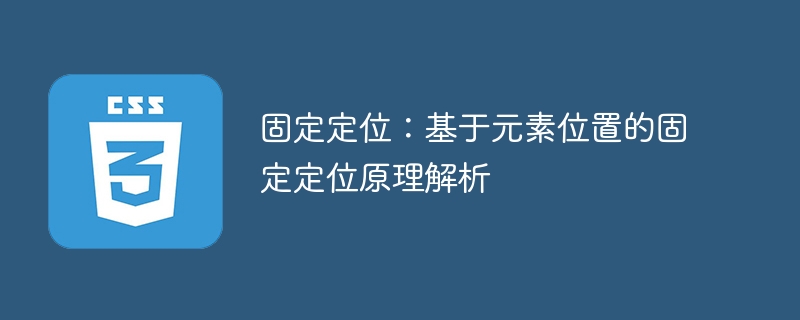

Fixed positioning: analysis of fixed positioning principles based on element position, specific code examples are required
If you have ever needed to fix the position of an element in web design or development , then you will use fixed positioning (position:fixed) in CSS. Fixed positioning is a CSS layout technique that can fix an element to a specific location on the page. In this article, we'll dive into how fixed positioning works and provide some concrete code examples.
The principle of fixed positioning is relatively simple. It determines the layout of the element based on its position in the browser viewport. When an element is set to fixed positioning, it will be laid out relative to a position in the browser viewport and will not change position as the page scrolls. This allows the element to always be visible and stay in a fixed position on the page.
To set an element to fixed positioning, just add the following code to its CSS style:
.element { position: fixed; top: 0; left: 0; }
In the above code,.elementis to be set to fixed The selectors of the positioned element,top:0andleft:0respectively indicate that the distance between the element and the top and left side of the browser viewport is 0, that is, the element is placed in the viewport. The upper left corner of the mouth.
In addition to thetopandleftproperties, CSS also provides several other position-related properties that can help us control the position of elements more precisely. Here are some commonly used fixed positioning properties:
top: Specifies the distance of the element from the top of the viewport.right: Specifies the distance of the element from the right side of the viewport.bottom: Specifies the distance of the element from the bottom of the viewport.left: Specifies the distance of the element from the left side of the viewport.Now, let’s go through a few code examples to better understand how fixed positioning works.
Suppose we have a top navigation bar on a page and we want it to stay at the top of the viewport as the page scrolls. The following is the corresponding HTML and CSS code:
.top-nav { position: fixed; top: 0; left: 0; background-color: #ffffff; width: 100%; padding: 10px; } .top-nav ul { list-style: none; margin: 0; padding: 0; } .top-nav li { display: inline-block; margin-right: 10px; } .top-nav li a { text-decoration: none; color: #333333; }
In the above code, we set a fixed positioning for the navigation bar container.top-navand passedtop: 0# The ## andleft: 0properties place it in the upper left corner of the viewport. Additionally, we set the background color, width, and padding, as well as the style of the navigation menu.
.ad-banner { position: fixed; top: 20px; right: 20px; width: 200px; } .ad-banner img { width: 100%; height: auto; }
marginorpaddingproperties of other elements to prevent overlap.
The above is the detailed content of Analyze the principle of fixed positioning based on element position. For more information, please follow other related articles on the PHP Chinese website!